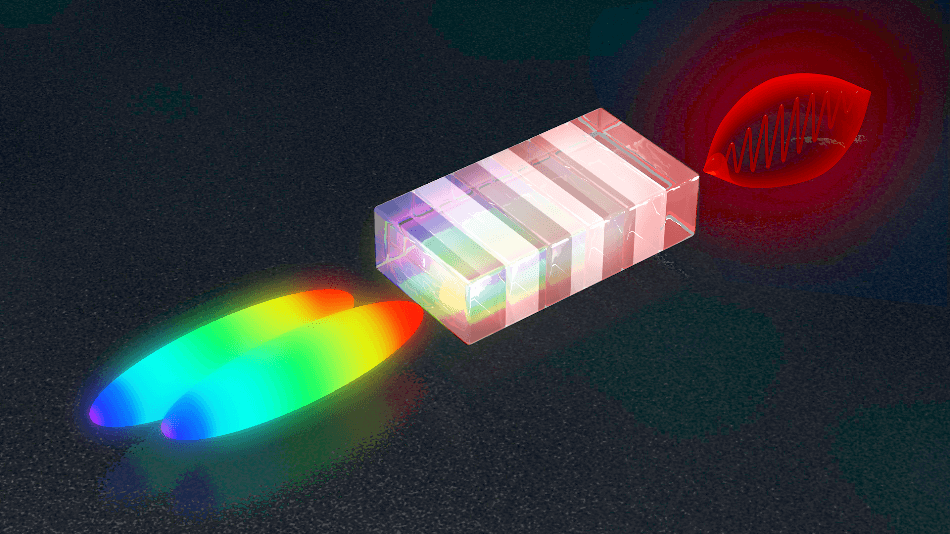 By Megan DaviesJun 14 2019
By Megan DaviesJun 14 2019Researchers from DESY and the University of Hamburg have accomplished a crucial milestone in the hunt for a new type of compact particle accelerator. With the use of ultra-powerful pulses of laser light, they managed to create very high-energy flashes of radiation having a sharply defined wavelength (color) in the terahertz range. Terahertz radiation will pave the way for a new generation of compact particle accelerators that can be utilized soon on a lab bench. The team led by Andreas Maier and Franz Kärtner from the Hamburg Center for Free-Electron Laser Science (CFEL) reveals their findings in the journal Nature Communications. CFEL is cooperatively run by DESY, the University of Hamburg and the Max Planck Society.
 From the color difference of two slightly delayed laser flashes (left) a non-linear crystal generates an energetic terahertz pulse (right). (Image credit: DESY, Lucid Berlin)
From the color difference of two slightly delayed laser flashes (left) a non-linear crystal generates an energetic terahertz pulse (right). (Image credit: DESY, Lucid Berlin)
The terahertz range of electromagnetic radiation falls between the microwave and infrared frequencies. Air travelers may be acquainted with terahertz radiation from the full-body scanners used by airport security to look for objects concealed beneath a person’s clothes. However, radiation in this frequency range might also be used to design compact particle accelerators. “The wavelength of terahertz radiation is about a thousand times shorter than the radio waves that are currently used to accelerate particles,” says Kärtner, who is a chief scientist at DESY. “This means that the components of the accelerator can also be built to be around a thousand times smaller.” The generation of high-energy terahertz pulses is thus also a vital step for the AXSIS (frontiers in Attosecond X-ray Science: Imaging and Spectroscopy) project at CFEL, sponsored by the European Research Council (ERC), which aims to open up totally new applications with compact terahertz particle accelerators.
However, chivvying along a considerable number of particles calls for strong pulses of terahertz radiation possessing a distinctly defined wavelength. This is exactly what the team has currently managed to develop. “In order to generate terahertz pulses, we fire two powerful pulses of laser light into a so-called non-linear crystal, with a minimal time delay between the two,” explains Maier from the University of Hamburg. The two laser pulses possess a kind of color gradient, meaning that the color at the front of the pulse is unlike from that at the back. The minor time shift between the two pulses thus results in a small difference in color. “This difference lies precisely in the terahertz range,” says Maier. “The crystal converts the difference in colour into a terahertz pulse.”
The technique needs the two laser pulses to be accurately synchronized. The researchers accomplish this by splitting a single pulse into two portions and transporting one of them on a short detour so that it is somewhat delayed before the two pulses are finally superimposed again. However, the color gradient along the pulses is not constant, in other words, the color does not vary evenly along the length of the pulse. Rather, the color varies gradually at first, and then increasingly quickly, creating a curved outline. Consequently, the color difference between the two staggered pulses is not steady. The difference is only suitable for creating terahertz radiation over a thin stretch of the pulse.
“That was a big obstacle towards creating high-energy terahertz pulses,” as Maier states. “Because straightening the colour gradient of the pulses, which would have been the obvious solution, is not easy to do in practice.” It was co-author Nicholas Matlis who presented the critical idea: he proposed that the color profile of just one of the two partial pulses should be stretched a little along the time axis. While this still does not change the degree with which the color varies along the pulse, the color variance with regards to the other partial pulse currently stays constant at all times. “The changes that need to be made to one of the pulses are minimal and surprisingly easy to achieve: all that was necessary was to insert a short length of a special glass into the beam,” reports Maier. “All of a sudden, the terahertz signal became stronger by a factor of 13.” Furthermore, the researchers used quite a large non-linear crystal to generate the terahertz radiation, particularly made for them by the Japanese Institute for Molecular Science in Okazaki.
By combining these two measures, we were able to produce terahertz pulses with an energy of 0.6 millijoules, which is a record for this technique and more than ten times higher than any terahertz pulse of sharply defined wavelength that has previously been generated by optical means. Our work demonstrates that it is possible to produce sufficiently powerful terahertz pulses with sharply defined wavelengths in order to operate compact particle accelerators.
Franz Kärtner, Research Lead, CFEL, University of Hamburg